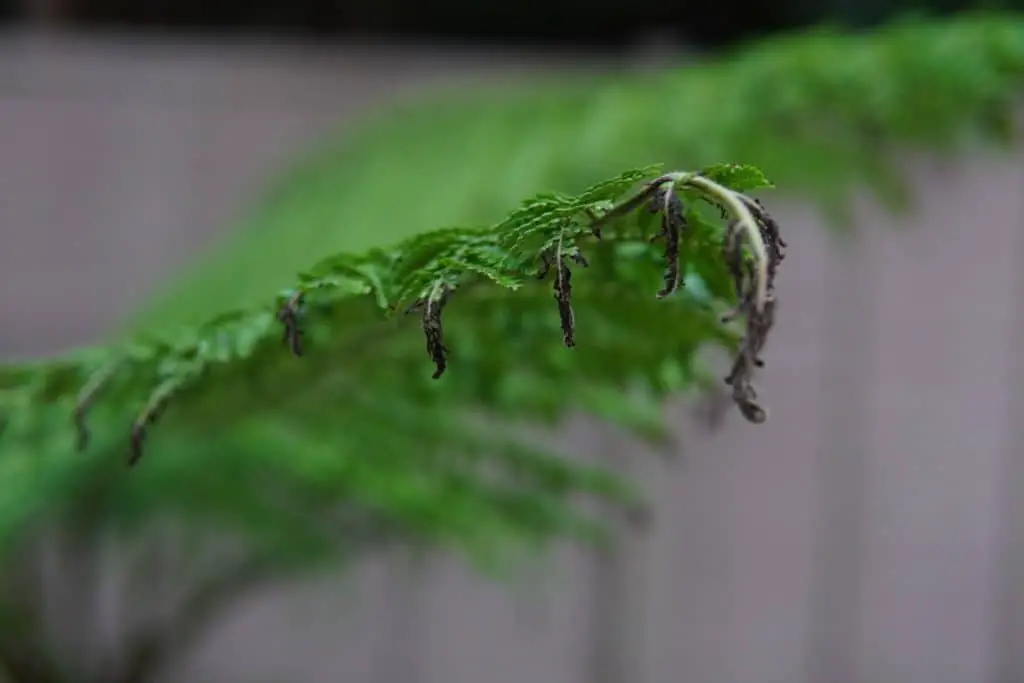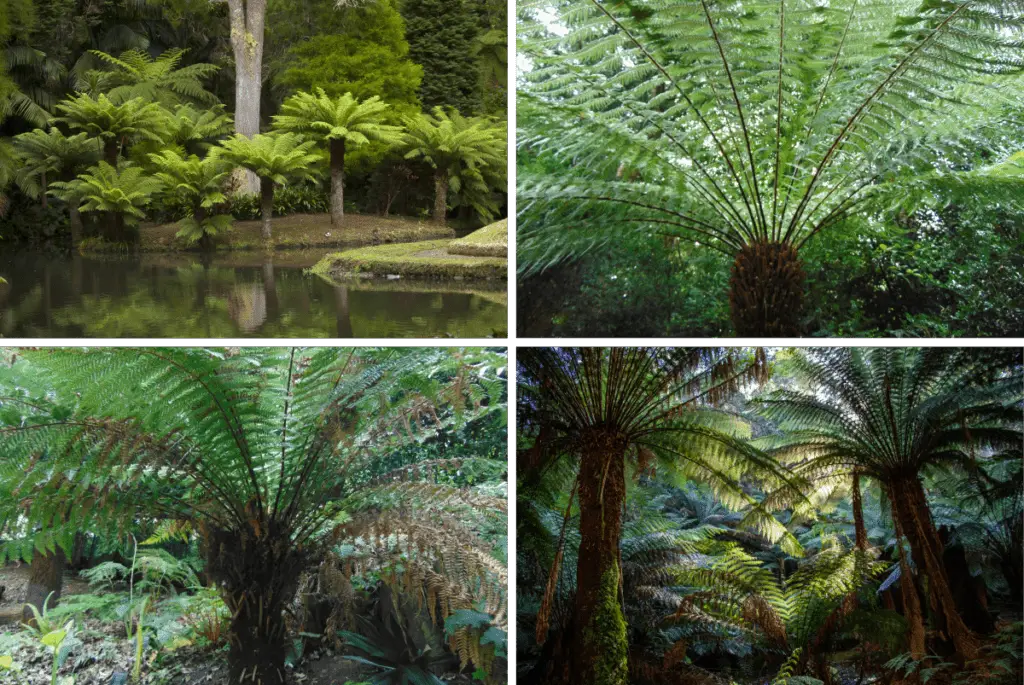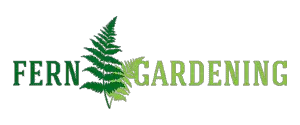Of all the varieties of ferns available for domestic cultivation, the tree ferns have to be the most impressive. One of the most readily available varieties is the Soft tree fern, Dicksonia antarctica, which has the distinct advantage of being able to survive the severe treatment of being cut off at the base and transported across the world as a bare trunk, which can then be replanted and successfully recover.
Despite this robust nature, there are some key factors that have to be considered when adding a tree fern to your yard – not least because even a small specimen can set you back hundreds of dollars.
Common names
- Soft tree fern
- Tasmanian tree fern
- Australian tree fern
- Woolly tree fern
- Man fern
Botanical names
- Dicksonia antarctica
Growth habit
Soft tree ferns have a spectacular canopy of fronds, which grow from a central crown and spread out in all directions, spanning several feet. As the fern ages, its rhizome forms a tough caudex of older dead material, which grows upwards as a trunk that slowly forms over many years. In the wild, specimens topping 40 feet have been recorded, but in cultivation the typical maximum height is around 15 feet.
The trunk, and the stipes of emerging fiddleheads, are covered in fine hairs that can be irritating to the skin and so are best handled with gloves.
Each year, new fronds will emerge from the growth zone at the top of the trunk. Older fronds can brown and die back with time, forming a skirt below the new growth. Although formally evergreen, cold winters (below about 20 °F, -5 °C) can kill older fronds making the fern appear deciduous
The trunk of Soft tree ferns is covered in roots, and so when replanting a bare trunk, the fern will regrow from the base, with the roots extending rapidly and widely below the soil.
If you buy a bare trunk, you will need to plant deeply enough to prevent the trunk from toppling in wind, but not so deep that you reduce the impact of that hard-grown height by burying it! A good compromise is to aim for about a foot underground for trunks of 5 feet and up, but you should be able to get away with half a foot underground for smaller specimens.
Hardiness
Dicksonia antartica originates from south Australia, and grows naturally and abundantly in the native rain forests and cloud forests of the region. It is the most hardy of the tree ferns, and can be grown successfully to hardiness zone 8, but it will need protection against temperatures below about 17 °F (-8 °C). The most vulnerable part of the plant is the growth zone, with a particular risk being water pooling in the top of the trunk and freezing.
The commonest strategy to protect against this is to pack the top of the trunk around the base of the fronds with straw or coir, and possibly wrap the top foot or so of the trunk with fleece or other insulating material that can breathe. In fact, taking these precautions is good practice any time temperatures are due to drop below freezing – to protect your investment if nothing else!
As well as the cold, Soft tree ferns should be protected from direct wind, which can toss around the large canopy of fronds and risk damaging the growth zone at the top of the trunk.
Sun exposure
Soft tree ferns need partial or full shade, as their natural habitat is beneath the canopy of temperate rain forests. They cannot tolerate full sun for long, and are vulnerable to high temperatures above around 95 °F.
A recent heatwave that reached 100 °F in the UK scorched the fronds of my Soft tree fern, despite near constant watering.

As such, this variety is not suited to hot states such as California or Arizona; other tree ferns (such as Cyathea species) would do better.
Watering
Dicksonia antarctica thrives in wet, humid conditions. The trunk should be regularly watered through the growth season, and in dry spells a thorough soaking should be administered daily. These ferns are adapted to damp forests, and so intolerant of drought.
The watering should be focused on the top of the trunk where the fronds emerge, as this is the active growth zone. That said, the whole trunk is covered in roots, and so the best policy is to give it a good soaking all over.
The base of the trunk should also be watered, as the roots will extend into the soil below ground to obtain nutrients and anchor the plant.
For those that find this regimen demanding, a good strategy is to set up a drip irrigation system at the crown of the trunk. This ensures a regular supply of water at the growth zone, which will also drain down over time and keep the rest of the trunk moist.
Watering is the most critical factor in tree fern survival.
Soil and fertilizer
Soft tree ferns can grown successfully in acid, neutral or alkaline soils. They can also be grown in pots, but this should be done with caution for larger specimens (say above 4 feet) as the root ball will grow so densely packed within the pot that the potting mix can be exhausted.
The other problem with growing tree ferns in pots is that a very substantial pot is needed, which becomes very heavy to shift.
For ferns in pots, a supplemental fertilizer is often recommended, and there are several brands of specialist “tree fern feed” that can be purchased. Used sparingly through the growing season, this can help enhance the size and spread of the canopy – some growers swear by this supplement even for tree ferns planted directly into the ground.
Propagation
Most Soft tree ferns are sold as bare trunks, and should be sourced from reputable suppliers that sell managed stocks that were approved for harvesting by the governments of Tasmania and Australia. Tree ferns grow at a rate of only an inch or so a year, meaning the largest specimens available for sale are several decades old. Harvesting involves literally sawing through the trunk at ground level, stripping the old fronds, and transporting the bare trunk by container shipment around the world.
Once replanted, the trunks will rejuvenate and form new fronds, but the cut off base left behind in Tasmania will not regenerate. It is therefore important to respect the careful management of this ancient and precious resource.
After about 20 years of growth, Soft tree ferns begin to produce spores, which can be used to propagate new plants. Although this is a reliable way to propagate, it also requires a lot of patience, as it will take many years for new fernlings to form a trunk and take on the classic tree fern structure.
Varieties and cultivars
There are around 20 species of Dicksonia tree ferns, with similar appearance and hardiness to the more common Dicksonia antartica. Other varieties than can be sourced for domestic planting include the rough tree fern (Dicksonia squarrosa), the Golden tree fern (Dicksonia fibrosa) and the Xaxim (Dicksonia sellowiana) – the last of which is native to South America.
These related varieties are not strikingly different in appearance or growth habit, and so rarely found for sale in comparison to Dicksonia antarctica.

Soft tree ferns are a fantastic way to make an statement in the garden. Despite the high cost, the value of the plants comes from their sculptural impact, and they are an essential centerpiece to any fernery. With good management of water and wind, they can last for decades, increasing in grandeur with every year.
